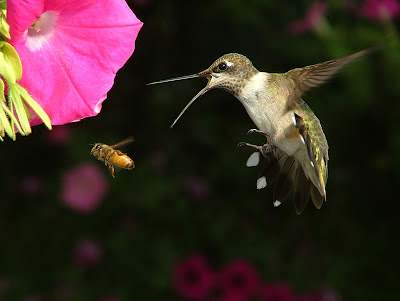Hummingbirds are among the smallest of all bird species. They are known as hummingbirds because of the sound created by their beating wings. They achieve this by rapidly flapping their wings 12–80 times per second, at this speed hummingbirds are able to hover in mid-air.
You can help to attract these gorgeous birds into your garden by offering an easier and more reliable source of food. Luckily, feeding hummingbirds is an easy, inexpensive and rewarding pastime. All you need is a suitable hummingbird feeder, granulated sugar, and some water.
How to feed hummingbirds
.jpg) |
| How to feed hummingbirds |
Nectar is a highly valuable source of energy which is found in the form of simple sugars, and these sugars fuel the hummingbirds intense flight.
However it is unrealistic for people to harvest their own nectar from flowers in order to attract hummingbirds, but a simple 'nectar replacement' is easily manufactured.
Mix 4 parts volume of water to 1 part volume of granulated sugar in a pan - do not use any other ingredients, substitutes for the sugar or anything else that you may think of. Just natural sugar and water, nothing else.
Bring the solution to a boil then remove from the heat. Stir it while it is heating until all of the sugar is dissolved. Don't boil it for long because that will change the ratio as water is boiled off.
 |
| Hummingbird food |
Cover and allow to cool before using or pouring into a sterilized storage bottle and storing it in the refrigerator. This makes refilling the feeder so easy that you won't mind doing it every few days.
When it comes to selecting a suitable hummingbird feeder, the most important things to consider are that they are easy to clean and easy to fill. This is because when it come to feeding hummingbirds your feeder must be kept as clean as possible and full of fresh nectar.
Make sure that when you are comparing hummingbird feeders you purchase one that easily comes apart and exposes all surfaces for cleaning - do not underestimate the importance of this.
 |
| How to feed hummingbirds |
If your feeder does not have red colouration on it, and you feel that it may be a problem, tie a piece of bright red ribbon or nursery tape on it to attract them. The birds will then explore around and find the nectar once they discover the feeder. Some feeders have perches and some do not. Hummingbirds do not need perches on feeders, but they will use them if they exist and you will get to see a special treat - a hummingbird sitting still!
What do Hummingbirds eat?
 |
| How to feed hummingbirds |
Unfortunately nectar is a poor source of nutrients, so hummingbirds meet their needs for protein, amino acids, vitamins, and minerals by preying on insects and spiders.
Hummingbirds do not spend all day flying as the energy cost would be prohibitive, so the majority of their activity consists simply of sitting or perching.
Hummingbirds feed in many small meals, consuming many small invertebrates and up to twelve times their own body weight in nectar each day.
 |
| Sleeping hummingbird |
It is a fine balance as hummingbirds are continuously hours away from starving to death, and are only able to store just enough energy to survive overnight.
To conserve energy while they sleep or when food is scarce, they have the ability to go into a hibernation-like state (torpor) where their metabolic rate is slowed to 1/15th of its normal rate.
For more information click onto:
INSECT EATING BIRDS
WHAT DO HUMMINGBIRDS EAT?







No comments:
Post a Comment